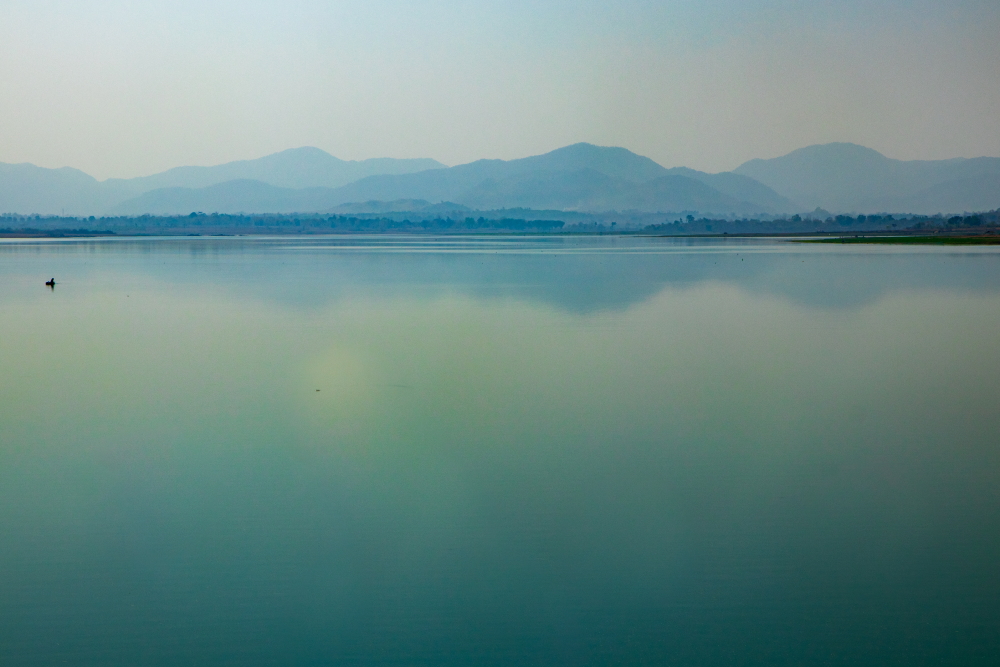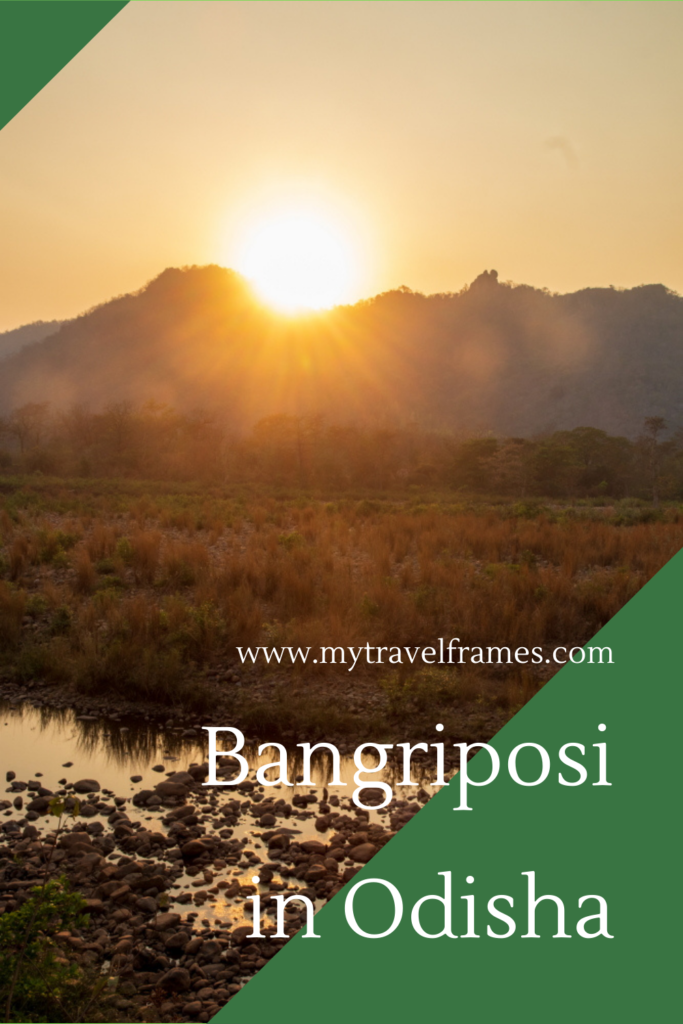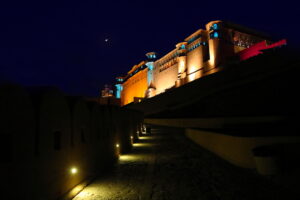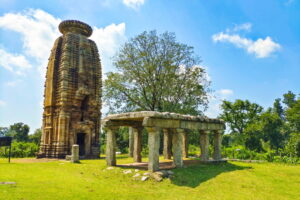Bangriposi, a name that I heard on a chilly December night in 2016 for the first time while I was doing my ER duty in the hospital. It was past midnight. I was having a chat with the on-duty sister about my last trip to Gorumara National Park when didi told me about Bangriposi, a small town in Odisha, where she went on a family trip preceding month. Since then, I had googled about the place many times, made weekend plans, but the trip never materialised. Finally, when I decided to go for our first post-pandemic road trip, I chose to start with Bangriposi (although initially, it was not the choice, and honestly, I am happy that I had changed my decision). Bangriposi is much more beautiful than what I thought and read in the novel “Bangriposir Du Rattir” (Bengali: বাংরিপোসির দু’রাত্তির) by Buddhadeb Guha. Bangriposi can be your love at first sight and the only unfulfilled love you would not regret. Rather you would like it to be the same way always so that you could come back again and again to find that unmet love.

Table of Contents
About Bangriposi
Bangriposi, once a tribal village and now a small town, is located in the Mayurbhanj district in Odisha. It is situated at the foothills of the Thakurani Hills and adjacent to Simlipal Forest. The NH6 that cuts Bangriposi across makes this destination easily accessible from Kolkata. Further ahead, the road turns right and disappears in the Thakurani Hills, while Bangriposi is left behind with its rustic landscapes, simple life and less travelled roads.
The little town of Bangriposi is off the main highway with its market, schools, college, railway station and a few administrative offices, including a police station. There is an old road through the market that connects Kuliana with Bangriposi, you take a turn from this road, and you will be on your way towards the tribal villages. The road goes across the railway crossing beside the Bangriposi station and the bridge on Budha Balang river (Buribalam river) towards the villages, continuing until it lost its way in Simlipal Forest.

On the north of the highway, the resorts are situated virtually standing on it. You stepped out of the NH6, and you have entered your hotel. And behind them, there is a small village connected by a road covered with red soil. On a spring afternoon, you can see large Palash trees blooming with red flowers while swirling smoke goes up from the paddy fields and disappears in the mist layering across the Thakurani Hills that borders the village at the far end. Somewhere up on the hill, there is the temple of Maa Dwarsini, who protects the inhabitants of the valley from above; and somewhere beyond those hills, there is a road that goes towards the iron ore mines of Badampahar and Gorumahishani.
You can drive towards the Simlipal Forest, you can walk across the villages to get a glimpse of the tribal lifestyle, you can reach to Buribalam river and sit on a rock to watch the sunset over the hills, or you can ascend along the highway towards the Ghat roads and enjoy a panoramic view of the valley from above; Bangriposi will always fulfil you with its laid back charm and abundant nature.

How to reach
Bangriposi can be reached both by rail and road. The NH6, which is also known as Kolkata-Mumbai Highway, goes across the town. The distance between Bangriposi and Kolkata is 230 kilometres. You can reach the place easily by a 4-5 hours drive from Kolkata. The route will be – Kolkata-Kolaghat-Kharagpur Chowranghee crossing-Lodhasuli-Baharagora-Jamsola-Bombay Chowki-Bangriposi.
Long-distance buses are available from Esplanade in Kolkata. You can take a bus to Baripada, get down at Bombay Chowki and take a shared cab to Bangriposi. If you take a bus to Keonjhar, it will take you to the resort door. But buses to Keonjhar usually starts in the evening from Kolkata, which means you will reach Bangriposi at midnight.
If you go by train, you have to reach Balasore in the morning. Then catch the Balasore-Bangriposi Demu Passenger and reach Bangriposi in another 2 and a half hours. Bangriposi is the terminal station on this line.

Where to stay
The best place to stay in Bangriposi is Khairi Resort which was previously an OTDC Panthanivas. Now it is taken in a lease by a local businessman who runs the property for the last few years. The old bungalow you will get the reference in Buddhadeb Guha’s novel is still there and open for tourists’ booking. There is another two-storied building adjacent to it where accommodation in ac and non-ac rooms are present. The old well is now used for water supply for all purposes, including drinking after it gets purified. There is an office building with a reception and provision for dormitories. The staff quarters are on the backside. The restaurant is right beside the highway and often visited by outside people apart from the guests. There is a decent amount of open space with lawn, garden and parking inside the compound.
The other places to stay in Bangriposi are the Bangriposi Resort and Simlipal Resort. Both of which are budget accommodations and are located beside Khairi Resort.
Khairi Resort: Contact: (+91) 8249002656, E-mail: simlipalkhairi.resort@gmail.com, Website: similipalkhairiresort.in, Google Map: Khairi Resort

Places to see
Brahman Kund
From Brahman Kund, the Buribalam or Budha Balanga river (one stream) originates and flows across Bangriposi. Brahmankund is nearly 25 kilometres from the main town, and you have to drive across many tribal villages to reach there. The place is right at the periphery of the Simlipal forest. There is a small water reservoir surrounded by rocky terrains with a small waterfall at one end, like other Kunds in Odisha. The water reservoir is full of fishes. Locals love to feed them as it is considered a good ritual. There is a large statue of the God Hanuman beside the Kund.
Buribalam river / Budha Balang river
The famous Buribalam river beside which Jatindranath Mukhopadhay (Bagha Jatin) fought against British Army flows near Bangriposi. Although the war was fought near Chandipur, where Baribalam meets the Bay of Bengal, sitting on a large rock on the Buribalam river bank near Bangriposi will definitely give you a goosebump if you are an Indian. The name Buribalam became synonymous with that event, which reminds us of the great sacrifice our ancestors made for our country’s freedom.
The river is locally known as Budha Balang. And I found that only a few locals know the name Buribalam. This stream of Budha Balang originated from Brahmankund and passed south until it meets the mainstream that plunges as Barehipani Falls in Simlipal Forest and continues towards coastal Odisha. Eventually, the merged stream meets the Bay of Bengal near Chandipur.

Maa Dwarsini Temple
Dwarsini Temple is situated on the Bangriposi Ghat roads that go towards Bisoi. The deity of this temple is Mata Dwarsini. This temple is also known as Bonbibi Temple and Kanak Durga Temple among locals. Goddess Dwarsini protects the people of the Bangriposi valley from above. The vehicles that go along the highway usually stop here to get blessings. A hiking trail starts near the temple that ends in a cave which eventually opens to a hill’s summit. One can go for an adventurous jungle hike through this trail. Although we did not go for the hike, I can pretty well imagine that the view from the summit will worth every effort. A fair is held every year beside this temple during the occasion of Makar Sankranti.
The place where the temple is located is called the door (Dwar in local language) to Simlipal Forest. It is at the beginning of Ghat Road and is at 3 kilometres distance from Bangriposi market.

Bisoi Haat
Tourists often visit Bisoi Haat, 18 kilometres away from Bangriposi, to glimpse the tribal culture in this part of the Mayurbhanj district. Bisoi arrives once you finish the Ghat road from Bangriposi and reaches the plain again. It is the first town that you will come across while going towards Jashipur along NH6. From Bisoi, the road to Rairangpur divides. Rairangpur block is the area of iron ore mines in Odisha. Every Saturday, a large village market sits near a playground in Bisoi, where locals come to buy and sell daily commodities. You can be lucky to visit a cockfight during your visit to Bisoi Haat.
Kuliana Village
Kuliana is a small village that comes on the way to Baripada from Bangriposi at 16 kilometres distance. This village is home to Dokra art workers. You can visit the village to see how Dokra artworks are made. Usually, they do not work during the monsoon as sunlight is necessary to dry up the paints. But you can always buy the artworks directly from the artists throughout the year at a very nominal price.

Bankabal Dam
Bankabal Dam is an irrigation dam created over Bankabal Nala, which meets the Khadkhai river after some distance. This Dam comes on the way to Rairangpur from Bisoi. It is a large reservoir with the Badampahar hill range visible on the other side. There are tribal villages on both sides of the dam. You can see locals busy in their daily activities while going towards the reservoir.
To reach Bankabal Dam, you have to take the road to Rairangpur from Bisoi and then take a left turn in Bijatala Chak. Then drive straight until you reach the Dam. You can drive your car over the Dam and come back again on the same route. The distance of Bankabal Dam from Bangriposi is 32 kilometres.
Sulaipat Dam
Sulaipat is another large reservoir at the foothills of the Badampahar Range. This Dam is constructed on the Khadkhai River, which is a tributary of the Subarnarekha River. The road beside the Dam goes inside Badampahar hills, where the iron ore mines are located. There is a small park beside the Dam. The road to Sulaipat Dam is equally beautiful and crosses a few tribal villages on the way. You can see beautiful paintings outside the walls of these tribal houses.
To reach Sulaipat Dam, you need to take a right turn at Baneikala and leave the highway. From there, the Dam is another 10 kilometres. You need to drive straight on the main road to reach the Dam. From Bangriposi. Sulaipat Dam is nearly 50 kilometres away.

Nearby attractions
Simlipal Forest
One can plan a trip to Simlipal Forest while in Bangriposi. It will take an entire day to visit the forest. Simlipal National Park is the seventh-largest national park in India. Simlipal is home to many wild animals like Bengal Tiger, Asian Elephant, Gaur etc. You can also visit some of the most beautiful waterfalls in the country, like Joranda waterfalls and Barehipani Falls. This national park is a part of the UNESCO World Network Biosphere Reserves since 2009.
There are two entry gates of Simlipal National Park, Pithabata and Jashipur, both of which are almost equidistant from Bangriposi. You can enter from one gate and come out through the other while return.
Few essential details:
- Same day permits are issued from Pithabata and Jashipur Forest Office.
- Permit time: 6 am – 9 am.
- Only LMVs with good ground clearance is allowed inside the forest.
- Entry fee: Adult – ₹100/person, Student – ₹30/person, Children below 3 years / Physically handicapped – no fee, Car entry – ₹100/day, Still camera charge – ₹100/first 3 days
- Required documents: Aadhar card (preferably) / Voter ID card
- Staying inside Simlipal Forest: You can book the Odisha Ecotourism nature camps online. You have to visit the forest office at one of the entry points and obtain a permit after showing your booking slip print-out. You can enter till 4 pm if you have a booking in one of the nature camps.
Baripada Town
Baripada is the largest town in the Mayurbhanj district. Baripada is situated beside the Budha Balanga river and was the last capital of the Bhanj Deo Dynasty. You can visit the old Mayurbhanj Palace, which is now a government college, you can visit centuries-old Jagannath Temple and Ambika Temple, you can enjoy the sunset at Deuli Dam, you can also stay at Belgadia Palace, which is the present day residence of the Bhanj Deo family.

When to go
The best time to visit Bangriposi is during winter between November-February when the days are pleasant and the nights are chilly. In monsoon, Bangriposi becomes more enchanting with many shades of green and the energetic Buribalam river. However, Simlipal Forest gets closed during the monsoon. In spring, you can see ample Palash trees blooming with red flowers.
Frequently asked questions
Bangriposi is at a distance of 230 kilometres from Kolkata.
Bangriposi is situated near the periphery of Simlipal National Park. There are two entry points in Simlipal National Park for tourists, one is Pithabata and the other is Jashipur. From Bangriposi, Pithabata and Jashipur are 54 and 60 kilometres respectively.
1. Khairi Resort
2. Bangriposi Resort
3. Simlipal Resort
You need 2 days to visit Bangriposi comfortably. You can cover all the places mentioned above in 2 days. If you want to visit Simlipal National Park, then you need one more day in your itinerary.


Pin the image to save the post and read it later!!




Pingback: Hills, Forests, Seabeach and Experiencing Royalty - All In One Trip | Will You Go For This Unique Road Trip in Odisha? - My Travel Frames
Pingback: A Magical Sunrise and A Miserable Dune-bashing In The Thar Desert, Rajasthan - My Travel Frames
Pingback: The Belgadia Palace in Odisha | A Place to Immerse Yourself in the History of Bhanj Dynasty - My Travel Frames